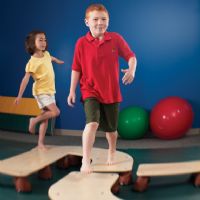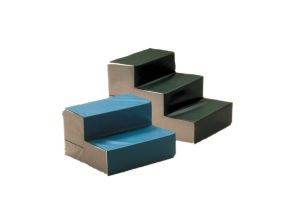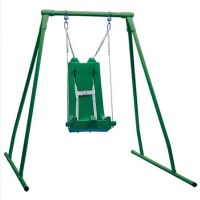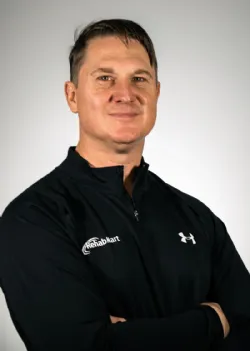 Written by Hulet Smith, OT
Written by Hulet Smith, OT
Gross motor skills are the foundation for developing more complex skills in the future, so they are a significant factor in a child’s growth. Gross motor activities help a child gain strength and confidence while exercising and enjoying physical movement. Since children learn so much through play, toys that facilitate gross motor activities are more than just fun, they are a critical part of helping a child achieve developmental milestones and reach their full potential.
Gross motor skills are the movements involved in the coordination of the arms, legs, and other large body parts including running, crawling, skipping, or hopping. Gross motor activities are important to practice since they help kids learn how to coordinate and control their bodies. These activities also influence the development of fine motor skills like grasping and pinching.
Gross motor skills are developed in the larger muscle groups and they facilitate children being able to hold up their heads, sit, crawl, walk, run, jump, and skip. Fine motor skills are the small movements in the hands, wrists, fingers, feet, toes, lips and tongue. Motor development refers to the growth and strengthening of a child’s bones, muscles and ability to move and interact with their environment through touch.
Often “big movements” are thought of as outdoor activities, but children can’t always be outside, and their development shouldn’t be hampered because of inclement weather or a physical condition that doesn’t allow them to safely be outside. There are plenty of indoor activities that can help foster gross motor skills.
 | Pediatric Balance Physical Therapy Bounce Disc View Product |
Requiring strength, power, balance, and coordination, jumping develops muscle strength and bone density. Jumping fosters coordination of upper and lower extremity movements and supports functional fitness, which is the fitness used in daily life activities. Jumping is good exercise, firing up metabolism and supporting cardiovascular health. Jumper’s Knee, or patella tendinopathy, can occur in anyone so pain in the front of the knee from jumping should not be ignored. However, tendon issues from jumping usually only occur with activities like volleyball and basketball.
 | Tumble Forms II Jettmobile View Product |
Crawling is considered the first form of independent movement, but it does so much more than get a child from place to place. Crawling helps develop the vestibular/balance system, sensory system, cognition, problem solving skills, and coordination. It allows for independent exploration and establishes body awareness how to best maneuver. Crawling also helps develop “reflexive strength," which refers to being able to respond to physical challenges with strength and stability, and without thinking, like when you right yourself and prevent a fall if you trip over something.
 | Bounce Path Track Balance System View Product |
Balance activities improve dynamic balance, automatic postural reactions and core strength. By building up their core muscles through these activities, children are able to maintain more stability while sitting or moving. This reduces the likelihood of injury and increases confidence in their own physical abilities. Balance facilitates walking, running, and other exercises that promote cardiovascular health, weight management, and bone, joint, and muscle strength.
 | Riverstones Play and Physical Therapy Stepping Play Stones View Product |
Step activities also help users improve balance, mobility, and spatial awareness. Similar to balance walking, stepping from one platform to another on uneven surfaces develops the skills and reflexes to be aware of their surroundings and remain upright. This reduces the risk of a fall and creates more body confidence. The skills developed and reinforced through step activities foster an active lifestyle that includes walking, running, and jumping.
 | In-FUN-ity Climbing System View Product |
Climbing is another strength-building activity that doesn’t have to be initiated outside if you have the right indoor equipment. As children decide where to place their hands and feet as they climb, they are sharpening visual perception and developing their vestibular systems, which contribute to good balance. Agility, speed, and coordination are also developed through climbing activities. Padding below the climbing area is essential to prevent injuries if there is a fall.
 | Padded Vestibular Stair Steps View Product |
Incorporating vestibular stair steps into indoor activities builds strength, improves balance, and supports physical conditioning. Stair work helps develop climbing skills and other gross motor skills, and is also valuable in rehabbing from injuries that impact mobility. Therapy stairs can be used throughout the day by more than one child, spreading out the benefits of investing in this equipment to multiple users.
Pedaling exercises increase hand-eye coordination and strength and mobility, they reduce complications from medical conditions, and can increase physical confidence. This activity also acts as training for trike or bike riding, which provides opportunities for socialization and joining in physical activities with peers. For kids with special needs, adaptive tricycles can open up the world to new social and therapeutic options. Check out The 5 Best Tricycles for a Child with Special Needs for recommendations on the best adaptive tricycles on the market.
 | Tumble Forms Neurodevelopmental Training Balls View Product |
Throwing helps develop hand-eye coordination and motor skills by using all the major muscle groups to maintain balance while exerting force to propel an object. Alternatively abled kids might not have full use of their fingers or hands. Tools that don’t require fine motor skills like grabbing and pinching can still help build gross motor skills if the equipment is adapted for a variety of users. Being properly weighted for children will minimize the risk of a strain injury, and being fun will maximize engagement.
Supporting balance and coordination with everyday activities like pushing and pulling integrates the movement with development of gross motor skills. Balanced pushing and pulling with weighted resistance engages major muscle groups and helps develop bilateral and motor planning skills and these activities can often be adjusted to accommodate growth and development.
Body awareness, also known as spatial awareness, helps kids relate to objects and people anywhere inside or out.They discover how they fit into their environment and what are appropriate reactions to things they encounter. A great way to support body awareness is through physical activity, especially active exploration of their space. In addition to balance, coordination, and strength, body awareness activities are also tied to the development of math skills.
 | Flaghouse Indoor/Outdoor Special Needs Pediatric Swing Frame View Product |
Swinging develops core muscles and helps develop balance while the child works to maintain postural position while shifting weight. Gross motor skills are further supported if kids are self-propelling the swing with the addition of pumping legs. For a child pushing another on a swing, there are additional benefits that support the development of strength, balance, and coordination while participating in this fun social activity.
Twisting is a non-locomotor activity, meaning it can be done in a stationary place. Twisting works the external oblique and entire range of central core muscles including transversus abdominis back and pelvis. Twisting can also incorporate pushing, pulling, and involve the entire upper body. It’s an entry-level activity for kids who aren’t strong or coordinated enough for more intensive gross motor activities. Since the lower extremities aren’t involved and standing, walking, and running are not required, the risk of a fall while developing gross motor skills is reduced.
 | Kore Design Floor Wobbler Balance Disc View Product |
Sit on Floor toys provide a way to expend energy while sitting without being disruptive. Kids with special needs might find it difficult to sit still, so floor seating that also offers sensory benefits does double duty in developing gross motor skills and meeting sensory needs. The sensory experience provided by these devices helps to reduce stress and boost concentration for a child with sensory processing issues.
 | Kore Design Wobble Chairs for Kids View Product |
Although sitting might not seem like it requires, or develops, many skills, it is a core activity for developing motor skills. It requires trunk, head, and neck strength and coordination to remain upright. Kids with special needs might find it difficult to sit still, and chairs that help them be comfortable as well as offer sensory benefits do double duty in developing gross motor skills and meeting sensory needs. Check out Special Needs Chairs for information on active seating and adaptive applications for sitting options that meet multiple needs while supporting gross motor skill development.
 | Mobo Wobo Mobo Cruiser by Asa Products View Product |
Rocking, along with walking and riding, is a major developmental milestone. Rocking trains the larger muscle groups to keep a child upright on the rocking apparatus. This exercise increases the coordination between hand, arm, and leg movements and improves motor skills, strength, and balance, while also increasing a child’s physical confidence.
There are several factors to consider when choosing indoor equipment to develop gross motor skills. Among the most important are safety, durability, size, usage, and ageability appropriateness. You can be confident that the products in our extensive catalog meet safety requirements and quality standards that ensure they will serve children well for years to come.
Choosing equipment that is too big to for the available space is inefficient in that it claims space that could be better used for something else and could pose a safety hazard if there isn’t enough room without obstruction for children to explore a piece of equipment’s full range of activities.
In a home setting, a piece of equipment might be used by only one child or a few members of a family. For school, equipment could be in use all day serving a large number of students with different ability levels and developmental needs. Customizability for home use is more valuable to serve an individual, while adjustability is more valuable for school use so a variety of children’s needs can be met.
Children develop as they grow, acquiring new skills and needing new challenges to progress. Equipment that can grow with them and continue to challenge them as they develop will have a longer service life.
Choosin age-appropriate equipment will lessen the chance of injuries that tend to happen when children use equipment that is too advanced for them. Generally equipment will be noted for use by children 2 years old and below, 2 to 5 years old, and 5 to 12 years old.
A: Fine and gross motor skills are required to accomplish daily activities like getting dressed and using the bathroom, they are necessary for good health that is supported by movement and exercise, they are necessary to engage in creative activities like dance and art, and they play a role in cognitive and academic success.
A: The best way to encourage the development of gross motor skills is to use play. Activities like jumping, climbing, and throwing can all be made more fun and more engagement when they are packaged like play rather than like therapeutic work.
A: Infants start developing gross motor skills, and these skills keep improving as the child grows. Although every child is different, in the first year a child has developed the strength and coordination to crawl, pull up to a standing position, and perhaps stand without assistance for a few seconds. By the time a child is two, generally they can walk, run, kick a ball, and climb stairs with assistance. By three, a child generally can balance on one foot for a few seconds, jump forward a foot or two, catch a large ball, and ride a trike. Between four and five kids are adept at walking, running, jumping, skipping climbing, hopping, and catching a ball and looking toward riding a two-wheeled bike.
A: They can be. Using large muscle groups in pushing and pulling exercises with items that have different feels and textures, sitting in a chair that rocks or sways, or walking or jumping through something wet or thick can tie sensory activities with gross motor skills.
A: There are many causes for poor gross motor skill development. When difficulties start in early childhood, a common cause is developmental coordination disorder (DCD), which is also sometimes called dyspraxia. In other cases, contributing medical factors can include premature birth that results in muscles developing more slowly, genetic causes (such as Down syndrome), nerve and muscle disorders (such as muscular dystrophy or cerebral palsy), developmental diagnoses such as autism, and hormonal causes such as hypothyroidism
A: Sitting, standing, walking, running, jumping, climbing, lifting, kicking, throwing, hopping, and other activities that require engagement and coordination of the body’s large muscle groups are gross motor skills.
A: According to CerebralPalsy.org, the primary effect of Cerebral Palsy is impairment of muscle tone, gross and fine motor functions, balance, control, coordination, reflexes, and posture. Swallowing and feeding difficulties, speech impairment, and poor facial muscle tone are also common.
A: Developmental Coordination Disorder (DCD) is a motor skills disorder that affects five to six percent of all school-aged children and occurs when a delay in the development of motor skills, or difficulty coordinating movements, results in a child being unable to perform common, everyday tasks. There is not an identifiable medical or neurological condition that explains the coordination problems kids with DCD experience.
A: The Lincoln-Oseretsky Motor Development Scale measures the motor ability of children aged 6-14. It is a 36-item scale involving a wide variety of motor skills such as finger dexterity, eye-hand coordination, and gross activity of hands, arms, legs, and trunk.
A: Yes, it does affect motor skills, as it is a group of diseases that cause progressive weakness and loss of muscle mass. Abnormal genes (mutations) interfere with the production of proteins needed to form healthy muscle, so the gross and fine motor skills that require muscle strength and movement are limited by muscular dystrophy.
Because gross motor skills are foundational, working on strength, balance, and coordination through targeted gross motor skill activities will impact multiple aspects of a child’s development. Making these activities more like play than work will encourage participation, engagement, and enjoyment for kids as they develop and learn more about their own capabilities and how to interact with the world around them. Rehabmart carries a large assortment of pediatric gross motor development products to support efforts to develop gross motor skills. For products designed for kids with special needs who will reap benefits from extra adaptive support, visit our Special Needs Store.
For indoor toys promoting gross motor skill development, one of the most important considerations is the space available and the space required by the equipment. Full enjoyment and user safety is achieved when the equipment can be set up correctly, with plenty of room for full exploration.
Thank you for reviewing our list of best indoor toys for gross motor activities. For more useful consumer information to help you make the best buying decisions, visit Caregiver University.

Co-founder/CEO of Rehabmart, Pediatric Occupational Therapist, husband, and father. Passionate about connecting special needs kids with superb nutrition, sensory integration, and complementary health strategies. Excited about Rehabmart's mission to become the premier online educational platform which empowers caregivers by spotlighting innovative devices and interventions to achieve optimal patient response and recovery.